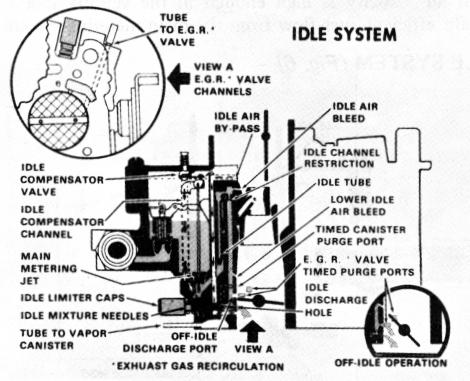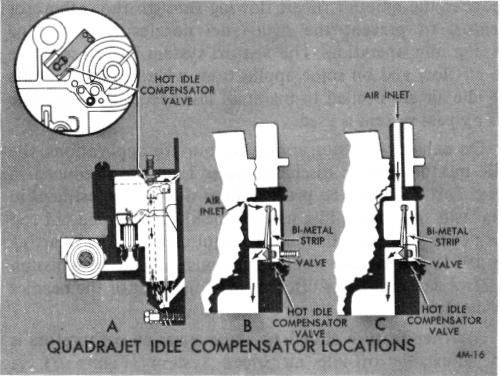MODELS 4M-4MC-4MV PAGE 8
In that the fuel tank is not vented to atmosphere and fuel vapors are collected in the vapor canister, purge ports for the canister are provided in the carburetor throttle body on certain Quadrajet carburetors. The purge ports lead through passages to a common chamber in the throttle body to a purge tube which connects by a hose to the vapor canister.
The purge ports may consist of what is called a constant bleed purge and a separate timed canister purge, or a separate timed canister purge only.
CONSTANT BLEED PURGE
The constant bleed purge operates during idle operation of the engine. This provides a constant purge of the canister at all times when the engine is running.
OFF-IDLE OPERATION
Along with the constant bleed purge for the canister, a timed bleed purge is used. The timed bleed purge port is located in each bore adjacent to the off-idle discharge ports. The timed purge operates during the off-idle range and also during part throttle to wide-open throttle operation. This provides a larger purge capacity for the vapor canister and prevents over-rich mixtures from being added to the carburetor metering at any time.
EXHAUST GAS RECIRCULATION (Fig. 7)
FIGURE 7
On some Quadrajet models (Figure 7), a vacuum signal to operate an Exhaust Gas Recirculation (E.G.R.) valve is supplied through a tube in the carburetor throttle body which connects to a vacuum signal port (or ports), located in the primary throttle bore. The ports supply a timed vacuum signal for E.G.R. valve operation in the off-idle and part throttle ranges of the carburetor.
As the primary throttle valve is opened beyond the idle position, the port for the E.G.R. system is exposed to manifold vacuum to supply a vacuum signal to the E.G.R. valve.
Some applications incorporate two punched ports located in the primary bore to supply a vacuum signal to the E.G.R. valve. As the primary throttle valve is opened beyond the idle position, the lower vacuum port for the E.G.R. system is exposed to manifold vacuum to supply a vacuum signal to the E.G.R. valve. To control the vacuum signal at the lower port, the upper port bleeds air into the vacuum channel and modulates the amount of vacuum signal supplied by the lower E.G.R. port.
As the primary throttle valve is opened further in the part throttle range, the upper port ceases to function as an air bleed and is gradually exposed to manifold vacuum to supplement the vacuum signal at the lower port to maintain correct E.G.R. valve position.
Thus, E.G.R. valve operation is "timed" for precise metering of exhaust gases to the intake manifold dependent upon location of the ports in the bore and by the degree of throttle valve opening.
The upper and lower E.G.R. ports connect to a cavity in the throttle body which, in turn, through a passage, supply the vacuum signal to the E.G.R. tube pressed into the front of the throttle body.
The E.G.R. vacuum signal port(s) is not exposed to manifold vacuum during engine idle and deceleration to keep the E.G.R. valve closed. This prevents rough idle which can be caused by excessive exhaust gas contamination in the air/fuel mixtures.
HOT IDLE COMPENSATOR (Fig. 8)
FIGURE 8
The Hot Idle Compensator, when used on 4MC and 4MV Quadrajet carburetors (View C) is located in a chamber at the rear of the carburetor float bowl adjacent to the

